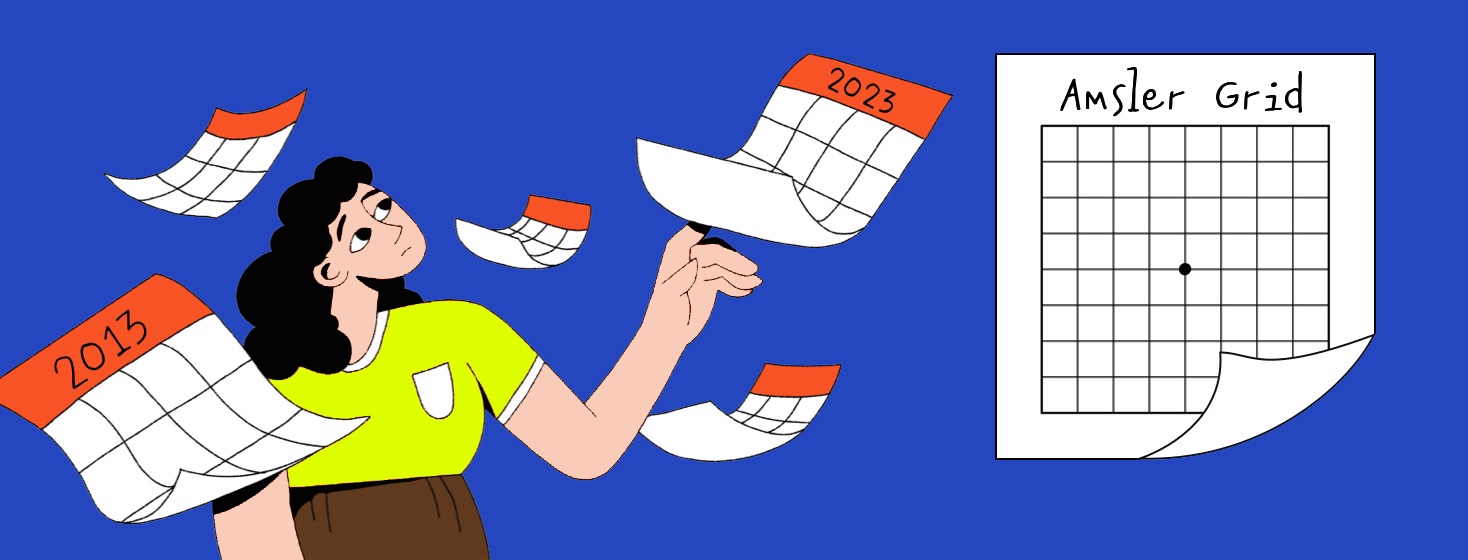My Diagnosis Story: Wendy
Ten years ago, I was diagnosed with dry age-related macular degeneration (AMD) by my optometrist. I was about 60 at the time.
At this memorable visit, the optometrist advised me that I had the beginnings of macular degeneration in my left eye. I thought, “Well, it really HAS happened now. It’s not just a theoretical possibility anymore.”
I asked her what I could do, although I knew from my parents that there wasn’t much I COULD do. Both of them had AMD, with my mother having the dry form and my father the wet form. The optometrist mentioned the AREDS2 supplements but said they hadn’t been shown to be effective for people with the very early stage. She gave me an Amsler grid, said I didn’t need to see a specialist, and sent me on my way.
The early stage of dry AMD
I had no symptoms at that time and had 20/20 vision. I did have a lot of floaters, which I noticed mainly when looking at the sky or at a plain white wall. Spreadsheet lines were a touch wiggly, but I put that down to needing to wear reading glasses. The wiggles disappeared if I had my specs on. Seeing in the dark was difficult for me, but it had been that way since I was young.
At this time, I did wonder if I should see an ophthalmologist rather than an optometrist. I probably would have gone down that route if I hadn’t already known about the disease from my family. I knew there was no actual treatment for dry AMD. I looked at the AREDS2 supplements, but the amount of zinc troubled me, so I didn’t take them.
AMD progression and my next steps
I had my next appointment with the optometrist a year later. She did an optical coherence tomography scan (OCT) as usual. She brought up the picture of the left eye and said there was no change. I heaved a sigh of relief. Then she said, “We’ll look at the right eye now. The worst thing that could happen is if we find it in that eye, too.”
And then she did! I bet she wished she could take back that ill-considered statement! It really upset me. It wasn’t the worst thing she could have found. Granted, it wasn’t good, but she could have found advanced AMD like geographic atrophy, or the wet form, or glaucoma as well. It was very early dry macular degeneration.
The next day I started looking for an ophthalmologist!
Managing AMD progression
Now that I had progressed to having AMD in both eyes, I found an eye specialist through a friend’s recommendation. She was very understanding and empathetic. The diagnosis of early dry macular degeneration in both eyes was confirmed. She gave me a booklet about the disease that explained lifestyle changes I could make. I came home with another Amsler Grid and a strong recommendation to start taking AREDS2 supplements (which I did) because of my family history. I kept seeing her yearly.
It must have been about 7 years later that the eye specialist told me I had progressed to the intermediate stage. She double-checked that I was taking the supplements. When I asked her if I could take some with less zinc, she said definitely not, mentioning my family history again.
She also advised me that I had small cataracts in both eyes.
I knew my AMD was progressing further
In 2022, which would be about 8 years after the original diagnosis, she said she could see a small area of atrophy in one of my eyes. One of the little drusen bumps on the OCT had flattened out, and that was a sign that the macula was thinning. She said at least it wasn't right in the centre of my vision, so that was one good thing.
By now, I’d also started to notice that straight lines looked wiggly with my left eye. I knew that meant further progression.
Seeking treatment from a new retinal specialist
My ophthalmologist asked me to see her every 6 months from then on. I had no problems with her, but I decided to find the best retinal specialist I could. After a lot of research, I changed to someone who is highly regarded in the field of macular degeneration. He is further away, and it involves traveling into the city to see him, but I think it will be worth it.
I keep taking my AREDS supplements, and I take saffron now, too. I check the Amsler Grid often and I walk each day, always wearing sunglasses.
My AMD story continues
That’s my macular degeneration story so far — I’m sure there’ll be more!
I take inspiration from my parents, who managed to cope with this disease and live a good life until their mid-nineties.
Editor's Note: As of August 2023, 2 drugs known as complement inhibitors — Syfovre® and Izervay™ — have been approved by the US Food and Drug Administration (FDA) to treat geographic atrophy (GA).

Join the conversation